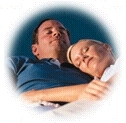
What is obstructive sleep apnoea?
Obstructive sleep apnoea is a debilitating sleep and breathing disorder defined as the cessation of
breathing for 10 seconds or more (an apnoea) at least five times per hour of sleep. During sleep, the body's
muscles relax, which can cause excess tissue to collapse into the upper airway (back of the mouth,
nose and throat) and block breathing.
When breathing is interrupted by an obstruction in the airway, the body reacts by waking enough to
start breathing again. These arousals may occur hundreds of times each night but do not fully awaken
the patient, who remains unaware of the loud snoring, choking and gasping for air that are typically
associated with obstructive sleep apnoea.
Obstructive sleep apnoea sufferers never get "a good night's sleep" because repeated apnoeas and
arousals deprive patients of REM and deep-stage sleep, leading to chronic daytime exhaustion and
long-term cardiovascular stress.
What are the health implications of obstructive sleep apnoea?
Obstructive sleep apnoea has a profound impact on an individual's health. Excessive daytime sleepiness
caused by disruption of normal sleep patterns leads to a significant increase in the rate of accidents
for obstructive sleep apnoea patients, including a sevenfold increase in automobile accidents.
Over the long term, obstructive sleep apnoea is associated with greater risk of hypertension and
cardiovascular disease and the National Commission on Sleep Disorders Research estimates that 38,000
cardiovascular deaths due to sleep apnoea occur each year.
In addition, loud snoring and intermittent breathing interruptions can affect the quality of sleep of
the obstructive sleep apnoea patient's bedpartner. Witnessing an apnoea can be a frightening
experience because the obstructive sleep apnoea patient appears to be suffocating. Frequently, it is
a sleep-deprived bedpartner who convinces the apnoeic patient to seek medical help.
Who suffers from obstructive sleep apnoea?
Twenty-four percent of adult men and nine percent of adult women are estimated to have some degree of
obstructive sleep apnoea. Of these, around one in three are estimated to have cases severe enough to
warrant immediate therapeutic intervention. However, obstructive sleep apnoea was not well understood
or recognised by physicians and general practitioners until recently, and only a fraction of
obstructive sleep apnoea patients have been diagnosed and treated.
With increased awareness in the doctor and patient communities, a growing number of new patients are
expected to be identified for treatment in the next few years.
While obstructive sleep apnoea is commonly associated with obesity and male gender, it affects a
broad cross-section of the population. Other risk factors include habitual snoring, which is often a
precursor of more serious upper airway disorders such as obstructive sleep apnoea. In fact, results
from a recent study indicate that one in three men and nearly one in five women who snore habitually
suffer from some degree of obstructive sleep apnoea.
Somnoplasty is one of the latest treatments for obstructive sleep apnoea


